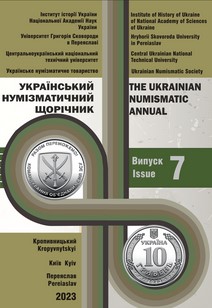НУМІЗМАТИЧНІ ЗНАХІДКИ З РОЗКОПОК ЦЕРКВИ НА ТЕРИТОРІЇ УЖГОРОДСЬКОГО ЗАМКУ ЗА 2018, 2019 та 2023 РОКИ
NUMISMATIC FINDS FROM THE EXCAVATIONS OF THE UZHHOROD CASTLE CHURCH IN 2018, 2019 AND 2023
Author(s): Volodymyr Moizhes, Andrii Boiko-HaharinSubject(s): Archaeology, History of Church(es), Economic history, Local History / Microhistory, 6th to 12th Centuries, 13th to 14th Centuries
Published by: ДВНЗ Переяслав-Хмельницький державний педагогічний університет імені Григорія Сковороди
Keywords: Hungarian Kingdom; Uzhhorod Castle; church ruins; archaeological research; money circulation of Transcarpathia; silver coins; coin counterfeits;
Summary/Abstract: The Hungarian coin is widely known among the finds on the territory of Ukraine, but it has remained outside the attention of the scientists, sporadically highlighting only some individual issues. The aim of the study is to introduce into the scientific circulation and analyze the numismatic material discovered by archaeologists during the expedition of the Uzhhorod National University during 2018 – 2023. Also we try to analyze the numismatic material discovered by archaeologists in the context of the circulation of Hungarian coins in Ukraine. The Conclusions. During the archaeological expedition of the Uzhhorod National University on the territory of the central nave of the Uzhhorod castle researchers discovered a significant number of coins from the Middle Ages and the early modern period, including contemporary forgeries. The largest number of coins discovered by archaeologists refers to Hungarian kingdom. The official coin in Hungary was first issued in 10th century, although the oldest Hungarian coins found in Transcarpathia date back to the reign of kings Koloman I Arpad (1095–1116) and István II Arpad (1105–1131). So it can be argued that the beginning of the penetration of Hungarian coins into Transcarpathia took place no earlier than the end of the 11th – the beginning of the 12th century, while the coin minting in Hungary lasted for more than a century. Large coins of Charles Robert (1307–1342) were quite widely distributed in Ukraine, the finds are known in the historical territories of Volhynia, Podillia, Bukovyna and Transcarpathia. One grosz of Charles I Robert (1307–1342) was also discovered during the excavations of the Uzhhorod castle. Until the end of the 14th century Hungarian coins were rarely found in Ukrainian lands but mostly Polish, Lithuanian, and Bohemian coins were in circulation. The Hungarian coins of Sigismund I of Luxemburg (1387–1437) had the most significant influx on the monetary market, at this time the new coin types appeared: parvuses, quartings and denars. The most famous coin of Sigismund I of Luxemburg (1387–1437) was parvus, the finds of which were spread in Transcarpathia. The complex of the numismatic finds discovered by the archaeological expedition of the Uzhhorod National University includes quartings and parvuses of Sigismund I of Luxembourg (1387–1437). In the vicinity of the castle the archaeologists also discovered a large amount of stylistically similar denars minted during the reign of Vladislav I Jagiellon (1440–1444), Albert Habsburg (1437–1439) and Janos I Gunyadi (1446–1458). During the reign of Mathias I Corvinus (1458–1490), denarius gained considerable popularity among the silver coins. A number of different types of coins were found on the territory of the Uzhhorod castle from low silver consist coins of 1467 to high-grade coins of 1471–1490.
Journal: Український Нумізматичний Щорічник
- Issue Year: 2023
- Issue No: 7
- Page Range: 89-123
- Page Count: 35
- Language: Ukrainian

